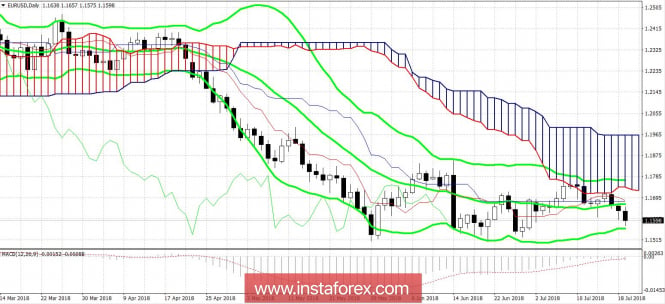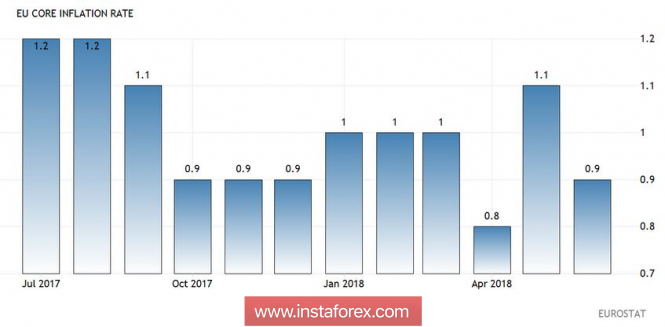The US currency once again "spread its wings". Today, the dollar index came to the borders of the annual maximum, demonstrating the dominance of the greenback throughout the market. The head of the Federal Reserve has dispelled many doubts and fears that have dominated the dollar over the past few weeks.
The European currency, in turn, does not have any weighty arguments to counter the quoted currency. The EUR/USD pair returns to the lows of this year, to the bottom of the 15th figure. However, even at these low prices, the price has been repeatedly over it the past six months. For a break below the bears, the pair needs a stronger reason than optimism about the Fed's further actions. Therefore, when reaching the original southern target of 1.1510, the sales of the pair should be treated with particular caution.

In general, the strengthening of the dollar looks reasonable. Powell has smoothed out all the uneven angles that have accumulated lately. There's the contradictory protocol of the June meeting of the Fed, an unexpected (albeit small) increase in unemployment, indistinct figures of US inflation, and a weak increase in the average hourly pay. Each listed fundamental factor did not pose a threat to the dollar but in aggregate, they created a somewhat nervous atmosphere especially on the background of the uneasy trade relations between the US and China.
Jerome Powell could increase pressure on the greenback. He could well focus his attention on the problematic aspects of the American economy, leaving the most powerful sides in the shadow. Officials of rank and Powell are very good at setting the right accents, shading and tactfully ignoring the necessary and unnecessary moments. The market, in turn, evaluates the performance in general, and in particular, analyzes the overall "aftertaste" of the speech. For example, last year, Janet Yellen's report in the Congress was diverse: if on the first day she supported the dollar with her rhetoric, then during the second part of her speech, the greenback suspended growth, as Yellen voiced a more cautious stance regarding the prospects for monetary policy.
However, Jerome Powell was consistent in his rhetoric, both on the first and second day of his speech in Congress. He expressed his confidence in the reduction of unemployment (thus eliminating the reaction to its growth to 4%), acknowledged the acceleration of growth in wages (though, comparing with last year's dynamics) and welcomed the growth of the US economy in the second quarter. However, a special impression on the market was made by his remark that large-scale fiscal incentives can "compensate" the consequences of the trade war. This is not a verbatim quote but the message was voiced precisely in this context. Although Powell expressed concern about the development of trade conflicts at the same time, these words remained in the shadow of the main message: the Fed will continue to tighten monetary policy, despite the foreign trade policy of the White House.
The result of the Fed's optimistic speech in the Congress can be expressed in figures: at the moment, the probability of raising the rate to 2.25% at the September meeting is 85% while the probability of raising the rate to 2.5% at the December meeting is almost 60%. Such a result became the main driver of the growth of the US currency, including the euro. The market did not pay attention to certain signals that could potentially threaten the large-scale strengthening of the dollar.
It's about a neutral interest rate level. As Jerome Powell himself admitted, the regulator is now looking for an answer to the question, exactly where is the given level at which the rate will not not serve as a stimulating character but will not limit economic growth. According to a number of experts, this issue will become more relevant next year. At the moment, the neutral level is in the "about three percent" area, that is, at 2.9%. However, this issue is the subject of discussion and the nearer the rate will approach the above-mentioned target, the stronger the dispute will be on this issue among members of the Fed. Depending on the rhetoric of the majority of the members of the Federal Reserve, the dynamics of the US currency will be determined.
However, all these are events are concerned with a distant future and certainly not today. Today, the dollar is "on horseback," in almost complete certainty that the rate this year will be raised to 2.5%. This is the reason for the growth of the dollar throughout the market. The European currency, in turn, lost all its points, especially against the background of the revised consumer price index. Core inflation in the euro area was reduced to 0.9%, although the initial estimate was more optimistic at 1%. In addition, after a series of "hawkish" rumors, fears returned to the market that the ECB will take a fairly "soft" position next week, in the light of the trade conflict between Washington and Brussels.

Such a fundamental background indicates that the EUR/USD pair has the potential to decline to the nearest support level of 1.1570 which is the bottom line of the Bollinger Bands indicator on the daily chart. Having broken this level, the bears will go to the annual lows in the area of 1.1510 but the further decline looks unlikely until at least the July meeting of the European Central Bank.
The material has been provided by InstaForex Company - www.instaforex.com